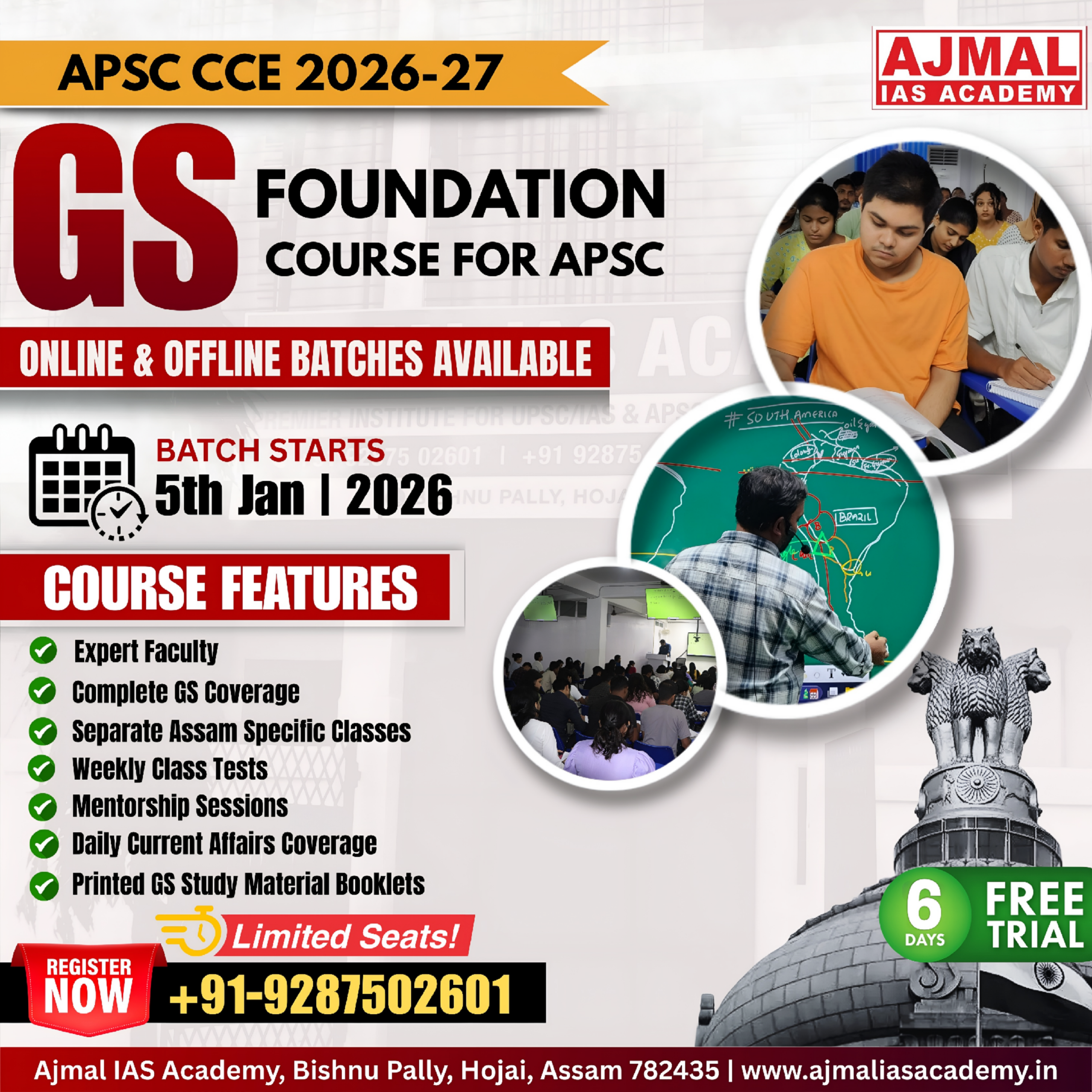Relevance (UPSC): GS-III Science & Technology (Space) | GS-III Disaster Management
The Sun powers life—and it also throws tantrums. Solar flares, coronal mass ejections (CMEs) and bursts of solar wind can disturb radio links, Global Positioning System, airline routes, satellites and even power grids. India is moving to self-reliance in solar physics and space-weather forecasting, anchored by its first dedicated solar observatory Aditya-L1 placed at Lagrange Point-1 (L1), about 1.5 million km from Earth. From this “front-porch” of the planet, Aditya-L1 gets an uninterrupted view of the Sun and samples the upstream solar wind—exactly what a forecaster needs.
What India is building
- Aditya-L1’s vantage and instruments. L1 allows continuous imaging of the Sun and provides 30–60 minutes of early warning when solar-wind conditions turn hostile. The mission carries remote-sensing payloads (e.g., a visible-line coronagraph to track CME lift-off, ultraviolet imagers to study the disk) and in-situ sensors (particle and magnetic-field detectors) to measure what actually hits Earth’s neighborhood.
- A national data and modelling pipeline. Space-weather centres in ISRO and partner institutes (ARIES, IIA, PRL, IISER groups) are knitting Aditya-L1 data with ground observatories (ionosphere, magnetometers, radio). The aim: nowcasts (what is happening) and forecasts (what will happen, when, and how strong).
- Private participation. Under the Indian Space Policy, 2023, IN-SPACe enables companies to build sensors, run prediction models, harden electronics, and deliver alerts to aviation, maritime, telecom and grid operators.
- Human capital. Workshops are drawing early-career researchers; universities are setting up shared instrumentation and compute. India needs more solar physicists, data scientists and space-system engineers to turn raw data into usable warnings.
Why space weather is a governance issue
- Economy: Satellites support crops insurance, logistics, digital payments and broadcast. Service outages cost crores in minutes.
- Safety: Airlines re-route polar flights during radiation events; fishermen and disaster-response teams rely on radio and satellite navigation.
- Grids and pipelines: Geomagnetic storms can induce currents that trip transformers and accelerate pipeline corrosion.
- Security: Defence communications and surveillance depend on stable radio and navigation.
The roadmap to self-reliance
1) Observe more, from more places
- Keep Aditya-L1 healthy; plan small follow-ons at L4/L5 to view the Sun’s “sides” and get multi-angle CME tracking.
- Add ground assets: all-sky H-alpha cameras, more magnetometers, and ionospheric sensors over the subcontinent and Indian Ocean.
2) Model better, faster
- Blend physics-based and Artificial Intelligence models; assimilate real-time data (coronagraph images + in-situ solar wind).
- Scale compute under the National Supercomputing Mission; publish model skill scores transparently.
3) Deliver sector-specific alerts
- Power: standard operating procedures for transformer de-loading, reactive-power support and situational patrols during storms.
- Aviation: radiation-dose and high-frequency radio maps for dispatchers; alternate routes pre-cleared by DGCA.
- Telecom & satellite ops: safe-mode triggers for satellites; anomaly logging to improve designs.
- Fisheries & maritime: simple advisories in coastal languages when navigation accuracy may degrade.
4) Build local industry
- Indigenous radiation-tested components, space-grade batteries and shielding; pilot lines for detectors and optics via the Anusandhan National Research Foundation (NRF) and ISRO.
- Government as first buyer for space-weather services; outcome-based contracts tied to forecast accuracy.
5) Share and learn globally
- Protocols with NOAA (USA), ESA and neighbouring countries for data exchange. Space weather is borderless; cooperation lowers risk.
Policy and institutional levers to remember
- Indian Space Policy, 2023 (private entry), IN-SPACe (single-window), NewSpace India Ltd. (commercialisation).
- ISRO’s Space Situational Awareness (SSA/NETRA) network—space weather must be integrated with debris and collision warnings.
- Disaster Management Act, 2005: space-weather advisories should sit in State disaster dashboards just like cyclone alerts.
- Data and ethics: open access to Aditya-L1 data with proper calibration; privacy-aware sharing for sector users.
Key terms
- Space weather: conditions on the Sun and in space that can affect technology on Earth.
- Solar flare: sudden brightening on the Sun that emits X-rays and radio bursts.
- Coronal Mass Ejection (CME): a huge bubble of magnetised plasma hurled into space; the chief driver of strong geomagnetic storms.
- Solar wind: a continuous stream of charged particles flowing out of the Sun.
- Geomagnetic storm: disturbance of Earth’s magnetic field caused by solar wind/CME impacts; can disrupt power and navigation.
- Lagrange Point-1 (L1): a gravitational sweet spot between Sun and Earth allowing a constant view of the Sun.
Exam hook
Use Aditya-L1 to connect science (how flares and CMEs form), technology (instruments, models), and governance (alerts for power, aviation, telecom). Show how Indian Space Policy, 2023 plus SSA/NETRA and NRF together create an indigenous, end-to-end space-weather system.
Key takeaways
- India is shifting from user to producer of solar-physics data and forecasts.
- Aditya-L1 at L1 gives continuous sight and early-warning minutes; next steps are more sensors, better models and focused advisories.
- Private firms, universities and ISRO must act as one ecosystem—with government as the first customer for reliable forecasts.
Using in the Mains Exam
Structure answers as Context → Risks from space weather → Aditya-L1 capabilities → Roadmap (observe–model–deliver–industrialise–cooperate) → Policy levers. End with how space-weather readiness protects Digital India and critical infrastructure.
UPSC Mains question
“Space weather forecasting is as much an economic and disaster-management need as a scientific pursuit.” Discuss India’s pathway to self-reliance with reference to Aditya-L1, data-model integration, sectoral alerting, private participation and international cooperation.
UPSC Prelims question
With reference to Aditya-L1, which of the following is/are correct?
- It orbits near Lagrange Point-1, allowing continuous observation of the Sun.
- Its payloads include both remote-sensing imagers and in-situ particle/magnetic sensors.
- Its primary goal is mapping lunar craters.
Answer: 1 and 2 only.
One-line wrap: Watch the Sun, warn the nation—Aditya-L1 is the start of an Indian space-weather shield that keeps our skies, satellites and grids safer.
Share This Story, Choose Your Platform!
Start Yours at Ajmal IAS – with Mentorship StrategyDisciplineClarityResults that Drives Success
Your dream deserves this moment — begin it here.


